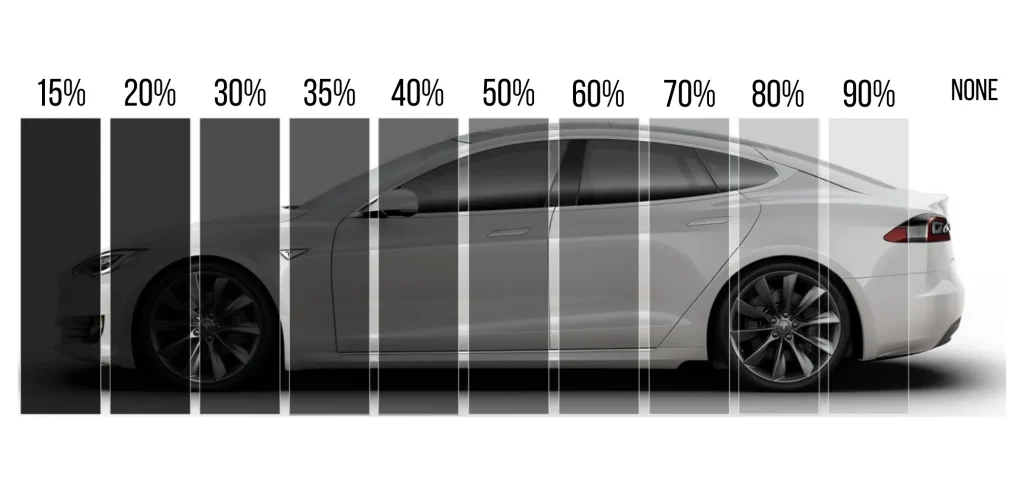THE BEST WINDOW TINTING COMPANY IN SANDTON
TINT MY WINDOWS
About us.
Tint My Windows is a trusted provider of expert window tinting and surface preparation services in South Africa. With years of experience, we’ve built a reputation for quality, reliability, and exceptional customer service. Our skilled team delivers tailored solutions for automotive, residential, and commercial clients, enhancing comfort, privacy, and style with precision and professionalism. We are committed to using top-quality materials and innovative techniques to exceed expectations and ensure long-lasting satisfaction. At Tint My Windows, we are passionate about transforming spaces and vehicles, creating environments that are both aesthetically pleasing and functionally superior.

Window Tint Darkness Chart: A Comprehensive Guide
Window tinting is a popular automotive and architectural modification that offers numerous benefits, including UV protection, heat reduction, glare reduction, and enhanced privacy. However, the darkness of window tint, measured in Visible Light Transmission (VLT), is regulated by laws that vary by state, country, or region. A Window Tint Darkness Chart is a useful tool to help you understand the legal limits and choose the right tint for your needs.
What is VLT?
Visible Light Transmission (VLT) is the percentage of visible light that passes through the window tint. For example:
5% VLT: Only 5% of light passes through (very dark, often called “limo tint”).
50% VLT: 50% of light passes through (medium darkness).
70% VLT: 70% of light passes through (lighter tint, closer to clear glass).
The lower the VLT percentage, the darker the tint and the less light that passes through.
Window Tint Darkness Chart
Below is a general breakdown of window tint darkness levels and their common applications:
| VLT Percentage | Tint Darkness | Common Uses |
|---|---|---|
| 5% | Limo Tint (Very Dark) | Maximum privacy; often used for rear windows in limousines or commercial vehicles. |
| 10% | Dark Tint | High privacy and heat reduction; popular for rear windows in SUVs and trucks. |
| 20% | Medium-Dark Tint | Balances privacy and visibility; commonly used for rear passenger windows. |
| 35% | Medium Tint | Moderate privacy and heat reduction; often legal for front side windows. |
| 50% | Light-Medium Tint | Subtle tint for UV protection and glare reduction; maintains good visibility. |
| 70% | Light Tint | Minimal tint; primarily for UV protection and heat reduction. |
| 90%+ | Clear or No Tint | No noticeable tint; standard clear glass. |
Legal Tint Limits by Window Type
Window tint laws vary widely depending on your location. Below is a general guide to typical legal limits for passenger vehicles in the United States:
Front Windshield:
Most states allow non-reflective tint on the top 4-6 inches (AS-1 line).
Some states permit 70% VLT or higher for the entire windshield.
Front Side Windows:
Legal limits typically range from 20% to 35% VLT.
Some states, like California, allow 70% VLT for front side windows.
Rear Side Windows:
Limits are often more lenient, ranging from 5% to 35% VLT.
SUVs, vans, and trucks may have different regulations.
Rear Windshield:
Similar to rear side windows, limits usually range from 5% to 35% VLT.
Factors to Consider When Choosing Tint Darkness
Legal Compliance: Always check your local laws to avoid fines or penalties.
Purpose: Decide if you prioritize privacy, heat reduction, UV protection, or aesthetics.
Visibility: Darker tints reduce visibility, especially at night or in low-light conditions.
Vehicle Type: SUVs, trucks, and sedans may have different tint regulations.
Climate: In hotter climates, darker tints can help keep the interior cooler.
Benefits of Window Tinting
UV Protection: Blocks up to 99% of harmful UV rays, protecting your skin and interior.
Heat Reduction: Reduces solar heat, keeping your car cooler in summer.
Glare Reduction: Minimizes glare from the sun and headlights.
Privacy and Security: Enhances privacy and deters theft by obscuring the view inside.
Aesthetic Appeal: Adds a sleek, stylish look to your vehicle.
Conclusion
A Window Tint Darkness Chart is an essential resource for anyone considering window tinting. By understanding VLT percentages and local regulations, you can choose the right tint darkness to meet your needs while staying compliant with the law. Whether you prioritize privacy, heat reduction, or UV protection, window tinting is a practical and stylish upgrade for your vehicle or property. Always consult a professional installer to ensure proper application and adherence to legal standards.
Get your project done.
Come & contact us today!
